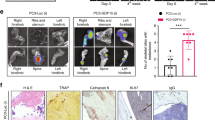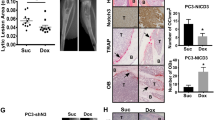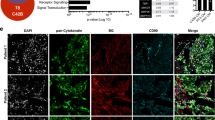Abstract
Bone marrow macrophages (BMMs) share common progenitors with osteoclasts and are critical components of bone–tumor microenvironment; however, their function in prostate tumor growth in the skeleton has not been explored. BMMs are the major source of inflammatory factors and proteases, including cysteine protease cathepsin K (CTSK). In this study, utilizing mice deficient in CTSK, we demonstrate the critical involvement of this potent collagenase in tumor progression in bone. We present the evidence that tumor growth and progression in the bone are impaired in the absence of CTSK. Most importantly, we show for the first time that BMM-supplied CTSK may be involved in CCL2- and COX-2-driven pathways that contribute to tumor progression in bone. Together, our data unravel novel roles for CTSK in macrophage-regulated processes, and provide evidence for close interplay between inflammatory, osteolytic and tumor cell-driven events in the bone–tumor microenvironment.
This is a preview of subscription content, access via your institution
Access options
Subscribe to this journal
Receive 50 print issues and online access
$259.00 per year
only $5.18 per issue
Buy this article
- Purchase on Springer Link
- Instant access to full article PDF
Prices may be subject to local taxes which are calculated during checkout









Similar content being viewed by others
References
Kingsley LA, Fournier PG, Chirgwin JM, Guise TA . Molecular biology of bone metastasis. Mol Cancer Ther 2007; 6: 2609–2617.
Lee RJ, Saylor PJ, Smith MR . Treatment and prevention of bone complications from prostate cancer. Bone 2011; 48: 88–95.
Roato I, D'Amelio P, Gorassini E, Grimaldi A, Bonello L, Fiori C et al. Osteoclasts are active in bone forming metastases of prostate cancer patients. PLoS One 2008; 3: e3627.
Chao TY, Wu YY, Janckila AJ . Tartrate-resistant acid phosphatase isoform 5b (TRACP 5b) as a serum maker for cancer with bone metastasis. Clin Chim Acta 2010; 411: 1553–1564.
Smith MR, Cook RJ, Coleman R, Brown J, Lipton A, Major P et al. Predictors of skeletal complications in men with hormone-refractory metastatic prostate cancer. Urology 2007; 70: 315–319.
Gelb BD, Shi GP, Chapman HA, Desnick RJ . Pycnodysostosis, a lysosomal disease caused by cathepsin K deficiency. Science 1996; 273: 1236–1238.
Saftig P, Hunziker E, Wehmeyer O, Jones S, Boyde A, Rommerskirch W et al. Impaired osteoclastic bone resorption leads to osteopetrosis in cathepsin-K-deficient mice. Proc Natl Acad Sci USA 1998; 95: 13453–13458.
Brubaker KD, Vessella RL, True LD, Thomas R, Corey E, Cathepsin K . mRNA and protein expression in prostate cancer progression. J Bone Miner Res 2003; 18: 222–230.
Littlewood-Evans AJ, Bilbe G, Bowler WB, Farley D, Wlodarski B, Kokubo T et al. The osteoclast-associated protease cathepsin K is expressed in human breast carcinoma. Cancer Res 1997; 57: 5386–5390.
Podgorski I, Linebaugh BE, Koblinski JE, Rudy DL, Herroon MK, Olive MB et al. Bone marrow-derived cathepsin K cleaves SPARC in bone metastasis. Am J Pathol 2009; 175: 1255–1269.
Pollard JW . Tumour-educated macrophages promote tumour progression and metastasis. Nat Rev Cancer 2004; 4: 71–78.
Porta C, Subhra Kumar B, Larghi P, Rubino L, Mancino A, Sica A . Tumor promotion by tumor-associated macrophages. Adv Exp Med Biol 2007; 604: 67–86.
Condeelis J, Pollard JW . Macrophages: obligate partners for tumor cell migration, invasion, and metastasis. Cell 2006; 124: 263–266.
Nonomura N, Takayama H, Nakayama M, Nakai Y, Kawashima A, Mukai M et al. Infiltration of tumour-associated macrophages in prostate biopsy specimens is predictive of disease progression after hormonal therapy for prostate cancer. BJU Int 2011; 107: 1918–1922.
Lin EY, Nguyen AV, Russell RG, Pollard JW . Colony-stimulating factor 1 promotes progression of mammary tumors to malignancy. J Exp Med 2001; 193: 727–740.
Scheven BA, Visser JW, Nijweide PJ . In vitro osteoclast generation from different bone marrow fractions, including a highly enriched haematopoietic stem cell population. Nature 1986; 321: 79–81.
Takeshita S, Kaji K, Kudo A . Identification and characterization of the new osteoclast progenitor with macrophage phenotypes being able to differentiate into mature osteoclasts. J Bone Miner Res 2000; 15: 1477–1488.
Bar-Shavit Z . The osteoclast: a multinucleated, hematopoietic-origin, bone-resorbing osteoimmune cell. J Cell Biochem 2007; 102: 1130–1139.
Gocheva V, Wang HW, Gadea BB, Shree T, Hunter KE, Garfall AL et al. IL-4 induces cathepsin protease activity in tumor-associated macrophages to promote cancer growth and invasion. Genes Dev 2010; 24: 241–255.
Miyamoto K, Ninomiya K, Sonoda KH, Miyauchi Y, Hoshi H, Iwasaki R et al. MCP-1 expressed by osteoclasts stimulates osteoclastogenesis in an autocrine/paracrine manner. Biochem. Biophys Res Commun 2009; 383: 373–377.
Mizutani K, Sud S, McGregor NA, Martinovski G, Rice BT, Craig MJ et al. The chemokine CCL2 increases prostate tumor growth and bone metastasis through macrophage and osteoclast recruitment. Neoplasia 2009; 11: 1235–1242.
Kawashima M, Fujikawa Y, Itonaga I, Takita C, Tsumura H . The effect of selective cyclooxygenase-2 inhibitor on human osteoclast precursors to influence osteoclastogenesis in vitro. Mod Rheumatol 2009; 19: 192–198.
Yoon DS, Yoo JH, Kim YH, Paik S, Han CD, Lee JW . The effects of COX-2 inhibitor during osteogenic differentiation of bone marrow-derived human mesenchymal stem cells. Stem Cells Dev 2010; 19: 1523–1533.
Qian BZ, Li J, Zhang H, Kitamura T, Zhang J, Campion LR et al. CCL2 recruits inflammatory monocytes to facilitate breast-tumour metastasis. Nature 2011.
Zhang J, Patel L, Pienta KJ . CC chemokine ligand 2 (CCL2) promotes prostate cancer tumorigenesis and metastasis. Cytokine Growth Factor Rev 2010; 21: 41–48.
Loberg RD, Ying C, Craig M, Yan L, Snyder LA, Pienta KJ . CCL2 as an important mediator of prostate cancer growth in vivo through the regulation of macrophage infiltration. Neoplasia 2007; 9: 556–562.
Abedinpour P, Baron VT, Welsh J, Borgstrom P . Regression of prostate tumors upon combination of hormone ablation therapy and celecoxib in vivo. Prostate 2011; 71: 813–823.
Smith MR, Manola J, Kaufman DS, Oh WK, Bubley GJ, Kantoff PW . Celecoxib versus placebo for men with prostate cancer and a rising serum prostate-specific antigen after radical prostatectomy and/or radiation therapy. J Clin Oncol 2006; 24: 2723–2728.
Valsecchi ME, Pomerantz SC, Jaslow R, Tester W . Reduced risk of bone metastasis for patients with breast cancer who use COX-2 inhibitors. Clin Breast Cancer 2009; 9: 225–230.
Singh B, Berry JA, Shoher A, Ayers GD, Wei C, Lucci A . COX-2 involvement in breast cancer metastasis to bone. Oncogene 2007; 26: 3789–3796.
Asagiri M, Hirai T, Kunigami T, Kamano S, Gober HJ, Okamoto K et al. Cathepsin K-dependent toll-like receptor 9 signaling revealed in experimental arthritis. Science 2008; 319: 624–627.
Zenger S, Hollberg K, Ljusberg J, Norgard M, Ek-Rylander B, Kiviranta R et al. Proteolytic processing and polarized secretion of tartrate-resistant acid phosphatase is altered in a subpopulation of metaphyseal osteoclasts in cathepsin K-deficient mice. Bone 2007; 41: 820–832.
Kiviranta R, Morko J, Uusitalo H, Aro HT, Vuorio E, Rantakokko J . Accelerated turnover of metaphyseal trabecular bone in mice overexpressing cathepsin K. J Bone Miner Res 2001; 16: 1444–1452.
Podgorski I, Linebaugh BE, Sameni M, Jedeszko C, Bhagat S, Cher ML et al. Bone microenvironment modulates expression and activity of cathepsin B in prostate cancer. Neoplasia 2005; 7: 207–223.
Teitelbaum SL . Bone resorption by osteoclasts. Science 2000; 289: 1504–1508.
Boyce BF, Yao Z, Xing L . Osteoclasts have multiple roles in bone in addition to bone resorption. Crit Rev Eukaryot Gene Expr 2009; 19: 171–180.
Lean JM, Matsuo K, Fox SW, Fuller K, Gibson FM, Draycott G et al. Osteoclast lineage commitment of bone marrow precursors through expression of membrane-bound TRANCE. Bone 2000; 27: 29–40.
Kiviranta R, Morko J, Alatalo SL, NicAmhlaoibh R, Risteli J, Laitala-Leinonen T et al. Impaired bone resorption in cathepsin K-deficient mice is partially compensated for by enhanced osteoclastogenesis and increased expression of other proteases via an increased RANKL/OPG ratio. Bone 2005; 36: 159–172.
Wilson SR, Peters C, Saftig P, Bromme D . Cathepsin K activity-dependent regulation of osteoclast actin ring formation and bone resorption. J Biol Chem 2009; 284: 2584–2592.
Mantovani A, Allavena P, Sica A, Balkwill F . Cancer-related inflammation. Nature 2008; 454: 436–444.
Shiirevnyamba A, Takahashi T, Shan H, Ogawa H, Yano S, Kanayama H et al. Enhancement of osteoclastogenic activity in osteolytic prostate cancer cells by physical contact with osteoblasts. Br J Cancer 2011; 104: 505–513.
Zhau HE, Odero-Marah V, Lue HW, Nomura T, Wang R, Chu G et al. Epithelial to mesenchymal transition (EMT) in human prostate cancer: lessons learned from ARCaP model. Clin. Exp Metastasis 2008; 25: 601–610.
McCabe NP, Madajka M, Vasanji A, Byzova TV . Intraosseous injection of RM1 murine prostate cancer cells promotes rapid osteolysis and periosteal bone deposition. Clin Exp Metastasis 2008; 25: 581–590.
Nakao S, Kuwano T, Tsutsumi-Miyahara C, Ueda S, Kimura YN, Hamano S et al. Infiltration of COX-2-expressing macrophages is a prerequisite for IL-1 beta-induced neovascularization and tumor growth. J Clin Invest 2005; 115: 2979–2991.
Conti I, Rollins BJ . CCL2 (monocyte chemoattractant protein-1) and cancer. Semin Cancer Biol 2004; 14: 149–154.
Wilson TJ, Singh RK . Proteases as modulators of tumor-stromal interaction: primary tumors to bone metastases. Biochim Biophys Acta 2008; 1785: 85–95.
Lynch CC . Matrix metalloproteinases as master regulators of the vicious cycle of bone metastasis. Bone 2011; 48: 44–53.
Saftig P, Hunziker E, Everts V, Jones S, Boyde A, Wehmeyer O et al. Functions of cathepsin K in bone resorption. Lessons from cathepsin K deficient mice. Adv Exp Med Biol 2000; 477: 293–303.
Mason SD, Joyce JA . Proteolytic networks in cancer. Trends Cell Biol 2011; 21: 228–237.
Reddy VY, Zhang QY, Weiss SJ . Pericellular mobilization of the tissue-destructive cysteine proteinases, cathepsins B, L, and S, by human monocyte-derived macrophages. Proc Natl Acad Sci USA 1995; 92: 3849–3853.
Chapman HA, Riese RJ, Shi GP . Emerging roles for cysteine proteases in human biology. Annu Rev Physiol 1997; 59: 63–88.
Punturieri A, Filippov S, Allen E, Caras I, Murray R, Reddy V et al. Regulation of elastinolytic cysteine proteinase activity in normal and cathepsin K-deficient human macrophages. J Exp Med 2000; 192: 789–799.
Buhling F, Reisenauer A, Gerber A, Kruger S, Weber E, Bromme D et al. Cathepsin K–a marker of macrophage differentiation? J Pathol 2001; 195: 375–382.
Saylor PJ, Lee RJ, Smith MR . Emerging therapies to prevent skeletal morbidity in men with prostate cancer. J Clin Oncol 2011; 29: 3705–3714.
Cook RJ, Coleman R, Brown J, Lipton A, Major P, Hei YJ et al. Markers of bone metabolism and survival in men with hormone-refractory metastatic prostate cancer. Clin Cancer Res 2006; 12: 3361–3367.
Smith MR . Osteoclast targeted therapy for prostate cancer: bisphosphonates and beyond. Urol Oncol 2008; 26: 420–425.
Desmarais S, Masse F, Percival MD . Pharmacological inhibitors to identify roles of cathepsin K in cell-based studies: a comparison of available tools. Biol Chem 2009; 390: 941–948.
Podgorski I . Future of anticathepsin K drugs: dual therapy for atherosclerosis and skeletal disease? Future Med Chem 2009; 1: 21–34.
Marquis RW, Ru Y, LoCastro SM, Zeng J, Yamashita DS, Oh HJ et al. Azepanone-based inhibitors of human and rat cathepsin K. J Med Chem 2001; 44: 1380–1395.
Bromme D, Lecaille F . Cathepsin K inhibitors for osteoporosis and potential off-target effects. Expert Opin Investig Drugs 2009; 18: 585–600.
Jensen AB, Wynne C, Ramirez G, He W, Song Y, Berd Y et al. The cathepsin K inhibitor odanacatib suppresses bone resorption in women with breast cancer and established bone metastases: results of a 4-week, double-blind, randomized, controlled trial. Clin Breast Cancer 2010; 10: 452–458.
Kumar S, Dare L, Vasko-Moser JA, James IE, Blake SM, Rickard DJ et al. A highly potent inhibitor of cathepsin K (relacatib) reduces biomarkers of bone resorption both in vitro and in an acute model of elevated bone turnover in vivo in monkeys. Bone 2007; 40: 122–131.
Palermo C, Joyce JA . Cysteine cathepsin proteases as pharmacological targets in cancer. Trends Pharmacol Sci 2008; 29: 22–28.
Robichaud J, Black WC, Therien M, Paquet J, Oballa RM, Bayly CI et al. Identification of a nonbasic, nitrile-containing cathepsin K inhibitor (MK-1256) that is efficacious in a monkey model of osteoporosis. J Med Chem 2008; 51: 6410–6420.
Bingle L, Brown NJ, Lewis CE . The role of tumour-associated macrophages in tumour progression: implications for new anticancer therapies. J Pathol 2002; 196: 254–265.
New DC, Wong YH . CC chemokine receptor-coupled signalling pathways. Sheng Wu Hua Xue Yu Sheng Wu Wu Li Xue Bao (Shanghai) 2003; 35: 779–788.
Lu Y, Cai Z, Xiao G, Keller ET, Mizokami A, Yao Z et al. Monocyte chemotactic protein-1 mediates prostate cancer-induced bone resorption. Cancer Res 2007; 67: 3646–3653.
Galvez BG, Genis L, Matias-Roman S, Oblander SA, Tryggvason K, Apte SS et al. Membrane type 1-matrix metalloproteinase is regulated by chemokines monocyte-chemoattractant protein-1/ccl2 and interleukin-8/CXCL8 in endothelial cells during angiogenesis. J Biol Chem 2005; 280: 1292–1298.
Cross AK, Woodroofe MN . Chemokine modulation of matrix metalloproteinase and TIMP production in adult rat brain microglia and a human microglial cell line in vitro. Glia 1999; 28: 183–189.
McQuibban GA, Gong JH, Wong JP, Wallace JL, Clark-Lewis I, Overall CM . Matrix metalloproteinase processing of monocyte chemoattractant proteins generates CC chemokine receptor antagonists with anti-inflammatory properties in vivo. Blood 2002; 100: 1160–1167.
Wolf M, Albrecht S, Marki C . Proteolytic processing of chemokines: implications in physiological and pathological conditions. Int J Biochem Cell Biol 2008; 40: 1185–1198.
Tanaka S, Tatsuguchi A, Futagami S, Gudis K, Wada K, Seo T et al. Monocyte chemoattractant protein 1 and macrophage cyclooxygenase 2 expression in colonic adenoma. Gut 2006; 55: 54–61.
Mancini A, Jovanovic DV, He QW, Di Battista JA . Site-specific proteolysis of cyclooxygenase-2: a putative step in inflammatory prostaglandin E(2) biosynthesis. J Cell Biochem 2007; 101: 425–441.
Lee RJ, Saylor PJ, Smith MR . Contemporary therapeutic approaches targeting bone complications in prostate cancer. Clin Genitourin Cancer 2010; 8: 29–36.
DeNardo DG, Brennan DJ, Rexhepaj E, Ruffell B, Shiao SL, Madden SF . Leukocyte complexity predicts breast cancer sorvival and functionally regulates response to chemotherapy. Cancer Discovery 2011; 1: 54–67.
Moin K, Day NA, Sameni M, Hasnain S, Hirama T, Sloane BF . Human tumour cathepsin B. Comparison with normal liver cathepsin B. Biochem J 1992; 285 (Pt 2) 427–434.
Kaighn ME, Narayan KS, Ohnuki Y, Lechner JF, Jones LW . Establishment and characterization of a human prostatic carcinoma cell line (PC-3). Invest Urol 1979; 17: 16–23.
Stone KR, Mickey DD, Wunderli H, Mickey GH, Paulson DF . Isolation of a human prostate carcinoma cell line (DU 145). Int J Cancer 1978; 21: 274–281.
Navone NM, Olive M, Ozen M, Davis R, Troncoso P, Tu SM et al. Establishment of two human prostate cancer cell lines derived from a single bone metastasis. Clin Cancer Res 1997; 3: 2493–2500.
Baley PA, Yoshida K, Qian W, Sehgal I, Thompson TC . Progression to androgen insensitivity in a novel in vitro mouse model for prostate cancer. J Steroid Biochem Mol Biol 1995; 52: 403–413.
Goswami S, Sahai E, Wyckoff JB, Cammer M, Cox D, Pixley FJ et al. Macrophages promote the invasion of breast carcinoma cells via a colony-stimulating factor-1/epidermal growth factor paracrine loop. Cancer Res 2005; 65: 5278–5283.
Weischenfeldt J, Porse B . Bone marrow-derived macrophages (BMM): isolation and applications. CSH Protoc 2008, 2008: pdb prot5080.
Andersen C, Bagi CM, Adams SW . Intra-tibial injection of human prostate cancer cell line CWR22 elicits osteoblastic response in immunodeficient rats. J Musculoskelet Neuronal Interact 2003; 3: 148–155.
Acknowledgements
We gratefully acknowledge Dr Lisa Coussens (UCSF, CA) for providing breeding pairs of immuno-deficient (FVB/N/N5, Rag-1−/−, Cat K+/+(WT)) and (FVB/N/N5, Rag-1−/−, Cat K−/− (CTSK KO)) mice, as well as immuno-competent (FVB/N/N5 Cat K+/+ (WT)) and (FVB/N/N5 Cat K−/− (CTSK KO)) mice used in this study. We also thank Dr Bonnie Sloane for providing CTSB antibodies, Dr Kamiar Moin and the Microscopy, Imaging and Cytometry Resources Core for assistance with confocal and conventional light microscopy analyses, and Dr Karin list for critical review of this manuscript. Grant support was provided by DOD PC074031, DOD PC030325, Wayne State University start-up fund and MICR: P30 CA 22453.
Author information
Authors and Affiliations
Corresponding author
Ethics declarations
Competing interests
The authors declare no conflict of interest.
Additional information
Supplementary Information accompanies the paper on the Oncogene website
Supplementary information
Rights and permissions
About this article
Cite this article
Herroon, M., Rajagurubandara, E., Rudy, D. et al. Macrophage cathepsin K promotes prostate tumor progression in bone. Oncogene 32, 1580–1593 (2013). https://doi.org/10.1038/onc.2012.166
Received:
Revised:
Accepted:
Published:
Issue Date:
DOI: https://doi.org/10.1038/onc.2012.166
Keywords
This article is cited by
-
Helicobacter pylori and gastric cancer: a lysosomal protease perspective
Gastric Cancer (2022)
-
Role of the bone microenvironment in bone metastasis of malignant tumors - therapeutic implications
Cellular Oncology (2020)
-
Lysosomal peptidases in innate immune cells: implications for cancer immunity
Cancer Immunology, Immunotherapy (2020)
-
Gut microbiota-stimulated cathepsin K secretion mediates TLR4-dependent M2 macrophage polarization and promotes tumor metastasis in colorectal cancer
Cell Death & Differentiation (2019)
-
Adipocyte-activated oxidative and ER stress pathways promote tumor survival in bone via upregulation of Heme Oxygenase 1 and Survivin
Scientific Reports (2018)



